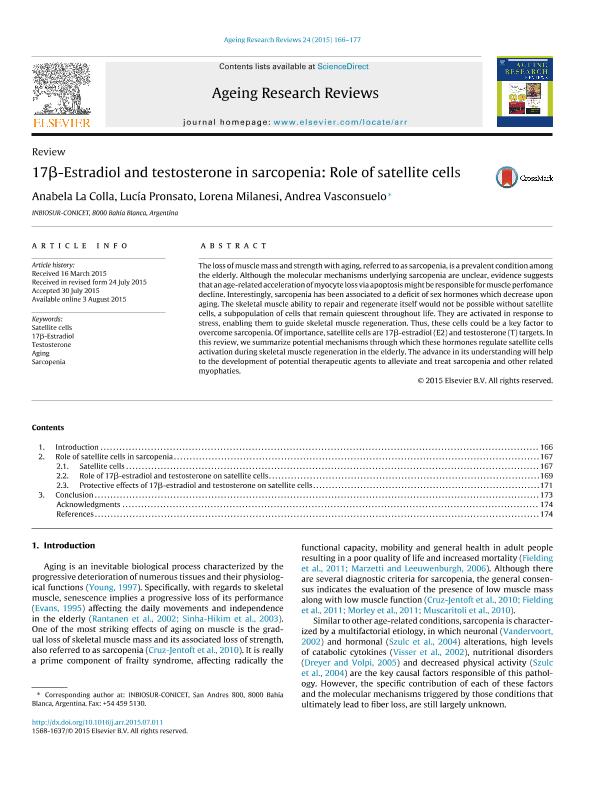Mostrar el registro sencillo del ítem
dc.contributor.author
la Colla, Anabela Belén

dc.contributor.author
Pronsato, Lucía

dc.contributor.author
Milanesi, Lorena Magdalena

dc.contributor.author
Vasconsuelo, Andrea Anahi

dc.date.available
2016-07-04T19:23:58Z
dc.date.issued
2015-08
dc.identifier.citation
la Colla, Anabela Belén; Pronsato, Lucía; Milanesi, Lorena Magdalena; Vasconsuelo, Andrea Anahi; 17-betaEstradiol and testosterone in sarcopenia: Role of satellite cells; Elsevier Ireland; Ageing Research Reviews; 24; Part B; 8-2015; 166-177
dc.identifier.issn
1568-1637
dc.identifier.uri
http://hdl.handle.net/11336/6336
dc.description.abstract
The loss of muscle mass and strength with aging, referred to as sarcopenia, is a prevalent condition among the elderly. Although the molecular mechanisms underlying sarcopenia are unclear, evidence suggests that an age-related acceleration of myocyte loss via apoptosis might be responsible for muscle perfomance decline. Interestingly, sarcopenia has been associated to a deficit of sex hormones which decrease upon aging. The skeletal muscle ability to repair and regenerate itself would not be possible without satellite cells, a subpopulation of cells that remain quiescent throughout life. They are activated in response to stress, enabling them to guide skeletal muscle regeneration. Thus, these cells could be a key factor to overcome sarcopenia. Of importance, satellite cells are 17β-estradiol (E2) and testosterone (T) targets. In this review, we summarize potential mechanisms through which these hormones regulate satellite cells activation during skeletal muscle regeneration in the elderly. The advance in its understanding will help to the development of potential therapeutic agents to alleviate and treat sarcopenia and other related myophaties.
dc.format
application/pdf
dc.language.iso
eng
dc.publisher
Elsevier Ireland

dc.rights
info:eu-repo/semantics/openAccess
dc.rights.uri
https://creativecommons.org/licenses/by-nc-nd/2.5/ar/
dc.subject
Satellite Cells
dc.subject
17b-Estradiol
dc.subject
Testosterone
dc.subject
Aging
dc.subject
Sarcopenia
dc.subject.classification
Bioquímica y Biología Molecular

dc.subject.classification
Ciencias Biológicas

dc.subject.classification
CIENCIAS NATURALES Y EXACTAS

dc.title
17-betaEstradiol and testosterone in sarcopenia: Role of satellite cells
dc.type
info:eu-repo/semantics/article
dc.type
info:ar-repo/semantics/artículo
dc.type
info:eu-repo/semantics/publishedVersion
dc.date.updated
2016-05-10T14:38:12Z
dc.journal.volume
24
dc.journal.number
Part B
dc.journal.pagination
166-177
dc.journal.pais
Irlanda

dc.journal.ciudad
Shannon
dc.description.fil
Fil: la Colla, Anabela Belén. Consejo Nacional de Investigaciones Cientificas y Tecnicas. Centro Cientifico Tecnol.conicet - Bahia Blanca. Instituto de Ciencias Biologicas y Biomedicas del Sur; Argentina
dc.description.fil
Fil: Pronsato, Lucía. Consejo Nacional de Investigaciones Cientificas y Tecnicas. Centro Cientifico Tecnol.conicet - Bahia Blanca. Instituto de Ciencias Biologicas y Biomedicas del Sur; Argentina
dc.description.fil
Fil: Milanesi, Lorena Magdalena. Consejo Nacional de Investigaciones Cientificas y Tecnicas. Centro Cientifico Tecnol.conicet - Bahia Blanca. Instituto de Ciencias Biologicas y Biomedicas del Sur; Argentina
dc.description.fil
Fil: Vasconsuelo, Andrea Anahi. Consejo Nacional de Investigaciones Cientificas y Tecnicas. Centro Cientifico Tecnol.conicet - Bahia Blanca. Instituto de Ciencias Biologicas y Biomedicas del Sur; Argentina
dc.journal.title
Ageing Research Reviews

dc.relation.alternativeid
info:eu-repo/semantics/altIdentifier/doi/http://dx.doi.org/10.1016/j.arr.2015.07.011
dc.relation.alternativeid
info:eu-repo/semantics/altIdentifier/doi/10.1016/j.arr.2015.07.011
dc.relation.alternativeid
info:eu-repo/semantics/altIdentifier/pmid/26247846
dc.relation.alternativeid
info:eu-repo/semantics/altIdentifier/url/http://www.sciencedirect.com/science/article/pii/S1568163715300131
Archivos asociados
